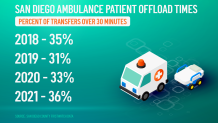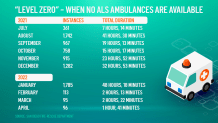When emergencies happen, seconds matter. We pay a lot of attention to how quickly ambulances get to the scene of an emergency, but picking up the patient is only half of the picture. The other half is what happens once that patient gets to a hospital.
NBC 7 Investigates discovered the trip from the parking lot into the emergency room can take hours. In some extreme cases, it’s taking more than two hours to transfer the care of a patient. Despite a wide awareness of the problem, lawmakers, ambulance providers and hospitals can’t seem to agree on a solution.
“It’s very concerning.… An ambulance gurney was really made for short response, short transport, not for the long time of being in a bed,” Jeff Behm, the managing director of Falck San Diego, the city of San Diego’s contracted ambulance provider, told us.
Behm shared some of Falck’s internal data with NBC 7 Investigates, showing how ambulances get tied up at hospitals. Each chart in the slideshow below shows the number of ambulances, hour-by-hour, that waited between 60 minutes and two hours to offload patients. Each slide shows a month, from December 2021 to April 2022.
California’s Emergency Medical Services Authority sets a goal time of 20 minutes to transfer the care of patients from ambulances to hospitals. Anything longer than that is considered delayed.
“We need to be out of the hospital in under 30 minutes because we need to get back out into the system to take care of those patients,” Behm said. “So any time over 30 minutes, to me, is not acceptable.”
This isn’t just a city problem. San Diego County keeps track of how long it takes to transfer every patient from an ambulance into the emergency room at all hospitals in the county. The county uses a system called FirstWatch, which collects data with a mobile app on board ambulances. It requires an emergency room physician or nurse to push a button acknowledging the transfer of care.
NBC 7 Investigates analyzed years of FirstWatch data. Even before the pandemic, about one in three ambulance patients waited more than 30 minutes to be admitted to the ER.

Some hospitals performed better than others. We looked at the 10 busiest in the county, based on the number of patients they see from ambulances. UC San Diego Medical Center in Hillcrest was the worst performer on average from 2018 through 2021. Nearly half of all ambulance patients waited longer than 30 minutes. Scripps Mercy San Diego and Scripps Mercy Chula Vista weren’t far behind. However, Scripps Memorial hospitals in La Jolla and Encinitas both averaged around 10% of patients with delayed ambulance offload times. Sharp Memorial hospital performed third-best at 20%.

Paramedics and EMTs call the time ambulances spend waiting to transfer a patient “waiting on the wall.” But a long wall time doesn’t just impact the patient in the ambulance. Until the transfer of care happens, that ambulance is offline, unable to respond to other emergencies.
That impact is felt in a variety of ways. Sometimes ambulances that are further away from emergencies are called on to respond, which can take longer. That can cause a ripple effect, causing ambulances in other service areas to leave their sectors to respond.
There are also times when there are no advanced life support ambulances, or ALS, available in the city. It has a name: “level zero.” NBC 7 Investigates learned it happens all the time.
During a level zero time, it doesn’t mean that no one will respond. It just means patients may get a basic life support ambulance, or BLS, instead. A BLS ambulance typically transports patients with minor injuries and doesn’t have as many life-saving medications and equipment on board as an ALS. The other option during level zero is to send an ALS fire truck.
When NBC 7 Investigates first reported on level zero times back in 2016 and again in 2018, the city told us it wasn'tt keeping track of them. But soon after, it started to collect the data. We filed a public records request and started counting.
Dispatch records from the city show from July 2021 to April of this year, there were 8,114 instances where no ALS ambulances were available to respond to a call. If you add up all of those times, it equals three days, 11 hours, 56 minutes and 23 seconds. In the data breakdown below, you can see a monthly breakdown of level zero times. It’s important to note that each instance does not mean there was a caller waiting for help, only a noted time when ALS ambulances weren’t available IF an emergency were to happen.

“Right now we’re bursting at the seams,” Sharp Memorial Chief of Staff-Elect Joseph Bellezzo, M.D., told us.
He said hospitals want to speed up ambulance patient offload times, but keeping up with patient volume is a challenge.
“We really want to get them back out on the streets doing what they do best,” Bellezzo said. “Sitting in a hallway waiting for a bed to open up is not the way that they are best serving their time. We really want to get them back out there.”
Bellezzo said a nationwide medical staff shortage has created a lot of turnover. That means more new workers who have to learn new systems, which ultimately slows down the patient intake process. However, Bellezzo said, staff is keeping pace with demand. Sharp Memorial just broke ground on an emergency department expansion, and he said he’s confident that will lead to faster ambulance offload times in years to come.
“You don’t want to build a freeway and have enough lanes for today,” Bellezzo told us. “You want to have enough lanes for the next 10 years. And that’s what we’re doing here: We’re creating enough lanes for the next 10 years.”
State lawmakers like Assemblymember Chris Ward, who represents District 78 in San Diego County, recognize the problem.
“I don’t have to give it a grade,” Ward said. “We either know that it is meeting standards or it is not. And it is not. And it is certainly not consistently across all our hospitals or all our regions or our county, and we must do better.”
Ward serves on California's Committee on Emergency Management, which recently discussed a bill that aims to lower ambulance patient offload times. Bill AB-1770 would, in part, fund a public education campaign to convince people not to call for an ambulance when they don’t need one. However, the bill stops short of fining hospitals for consistently long times. When pressed, Ward said he’d keep an open mind.
“Sure. Put it on the table so we can look at that and decide what is fair and what also will most importantly make a difference for those who need immediate care,” Ward said.
The bill has gotten some backlash from ambulance providers like Global Medical Response, which operates AMR locally. It filed this statement in opposition during a Committee on Emergency Management hearing in April.
“... The only real solution to improving bed delays are establishing an aggressive hospital fine structure for noncompliance, canceling elective surgeries for hospitals that routinely fail to meet the standard 20-minute patient turnover time, utilizing nursing assistances to manage patient intact instead of EMS personnel, and freezing nurse to patient ratios during times of disaster or multi-casualty events.”
County officials do have one option to hold hospitals accountable for lengthy ambulance patient offload times. They can put them on bypass, which removes them as an emergency room option for ambulances until they speed up offload times.
Behm said he doesn’t have all of the answers but has some ideas on how to improve ambulance patient offload times. He told us he reached out to every San Diego County hospital CEO to try to meet with them, but no meetings ever materialized.
“We don’t need to point fingers at each other,” Behm said. “That’s not going to get anything done. Let’s sit down and talk about it. We’re part of the healthcare system, and together we can work it out and figure out a way to do it.”
Behm said whatever the solution is, now is the time to act. He said it’s critical to prepare for the next COVID surge.
It’s also important to understand how these long offload times impact the medics working on the ambulances.
“If you can turn your patient over in due time, you can get back to your station and have some rest,” Behm said. “But if you’re sitting in a hospital waiting, you’re not resting, you’re caring for a patient.”
NBC 7 Investigates reached out to the three healthcare companies that operate the five hospitals with the highest percentages of ambulance patient offload times over 30 minutes. Two of them questioned the accuracy of the data used in our report. We asked them why and they never responded. Both San Diego County and Falck told us the FirstWatch data is reliable. You can read the hospitals’ statements below:
“Patient care and safety is our first priority at UC San Diego Health, particularly when addressing critical situations in our emergency departments. The data referenced is the result of an existing reporting system that does not ensure consistency between organization-reported measures and metrics. Even with the best intentions of the institutions within our community, the current absence of standardized data metrics and definitions means that these numbers do not, in our opinion, provide a reliable means of comparing institutions. The current system permits variances in reporting measures and protocols, resulting in inaccurate timestamps of EMS turnover times, which are then passed on to the San Diego County’s FirstWatch database.
The need to create efficient, accurate transfer-of-care processes is of utmost importance, and there are efforts underway to standardize the data acquisition process across the county related to ambulance call volume and transfer-of-care times. Doing so will create greater transparency and comparability among hospitals. We are hopeful that successful standardization of regional reporting practices will yield more accurate, effective reports that represent the lifesaving work our clinical teams provide each day.”
UC San Diego Health
“We question the accuracy of the off-loading data used as the basis of this story, and believe our off-loading times are better than what the data indicate. Staff members at all Scripps Health hospitals work tirelessly to expedite the off-loading of patients brought in by ambulance. However, there are situations when off-loading times are affected by a wide range of conditions both inside and outside hospitals -- many of which cannot be controlled -- including COVID surges, mental health patients held in emergency departments due to a lack of behavioral health beds in the county, delays in discharging some inpatients to skilled nursing facilities, congestion caused by other hospitals being on ED diversion, and patients coming to the ED for health issues better treated elsewhere.”
Scripps Health
“The timeframe of 2018-2021 captures the first two years of COVID-19. That alone created a huge challenge for all hospitals/emergency rooms, but especially for Sharp Chula Vista Medical Center and Sharp Grossmont Hospital, which both carried high COVID-19 patient volumes. We are encouraged that even though the emergency rooms at Sharp Chula Vista Medical Center and Sharp Grossmont Hospital are among San Diego’s busiest, the most recent data show that median offload times have improved.”
Sharp Healthcare

